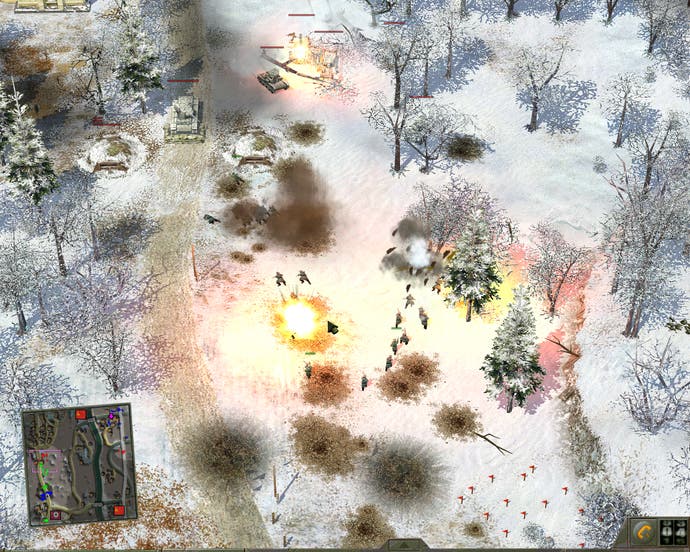Blitzkreig 2: Fall of the Reich
Comes with free cyanide pill for your dog.
Would every games reviewer that has ever started a review of a WW2 RTS with a sentence along the lines of "Oh God, not another WW2 RTS!" please go and stand next to that precipice over there.
Keep going. Keep going. Fantastic, that's perfect.
Right, now I'd like you all to stand really really still while my assistant here (Hans) removes the tarpaulin from this tripod-mounted Machinengewehr 42, gets comfortable, and commences firing.
Away you go Hans.
BRRRRRRRP-BRRRRRRRRP BRRRRRRRRRRRRRRRRRRRRRRRRRRRRP. BRRRP-BRRRP.
Excellent. Thanks for your co-operation folks. This has been a public information massacre on behalf of the You-probably wouldn't-bash-a-sci-fi-or-fantasy-RTS-on-the-basis-of-its-subject-matter -so-please-refrain-from-doing-the-same-when-faced-with-a-WW2-RTS Society. Now, we can get on with the review.
Honey, I shrunk the Honey
You'll have gathered from the above that I'm one of those charming eccentrics that's still enthusiastic about games featuring shrunken Shermans and titchy Tiger tanks. Recent titles like Company of Heroes and Faces of War prove this well-stocked sub-genre still has a lot left to give as long as designers find an original angle, evoke the drama, or deliver a sufficiently rich tactical experience. Just because developers occasionally fail in all of these areas, serving-up tired, forgettable mediocrities like this sad standalone expansion pack for Blitzkrieg 2, doesn't mean the theme itself is worn out.

Fall of the Reich manages to be about as eye-catching as Stalingrad super-sniper Vasily Zaitsev by foolishly setting both its campaigns on the Eastern front during the final phase of WW2, introducing bugger-all in the way of new unit types, and adding no significant gameplay enhancements. BK2 veterans perusing the feature list will be struck by the chronic lack of ambition, newcomers, the startling lack of variety. One of the most appealing aspects of the now-budget-priced parent game was the wide selection of theatres and playable powers it offered. In addition to the rubbled towns and churned fields of Europe, battles raged through sweaty Asian jungles and desiccated African deserts. On reflection perhaps Nival should have held back some of these exotic settings for this add-on.
The two campaigns we've got here are inspired by the costly last-ditch defence of Kurland (Hitler orders a pointless defence of present-day Latvia) and Operation Bagration (the Soviets smash through Byelorussia into Poland). Missions are all prefabricated but there's limited choice in the sequence order thanks to a simple map-based selection system. Fail a scenario and you can come back to it later with a better choice of reinforcements (each victory adds new unit types to the reserves roster). Whether you'll actually want to return is another matter.
Poor bloody infantry
Here's how a typical FotR scenario plays out. See if you like the sound of it.
After a short text briefing (sadly, no empathy-enhancing cut-scenes here) you usually find yourself hovering kestrel-like above a road, field, or wood in which sits a gaggle of expectant infantry squads and armour. Ahead, obscured by grey murk, is your objective - often a village, town, bridge or railway station. Grabbing some grunts you move off. Within seconds this doomed vanguard spots and is spotted by trench-cowering defenders, sandbagged AT guns and waiting armour. Quickly you call in artillery and SPG bombardments and desperately try to withdraw what's left of your recon force. The stonk arrive almost instantaneously. Explosions stomp up and down the enemy line like giant invisible elephants. Eventually you get bored of indirect death-dealing and send your infantry up again with clusters of tanks in close support. More explosions, health bars melt like icicles on burning eves, vehicles grind to a halt, buildings crumble into rubble. Stillness returns.

Before you advance towards the next knot of trenches, guns, and tanks, there's time to use the reinforcement menu (usually you can do this half-a-dozen times during a scenario) and bring forward your precious repair trucks (not always available). Most of your riflemen and submachine-gunners were slaughtered in that last exchange but as a troop of tanks are just as cheap as a troop of infantry it's tempting to restock solely with armour. With repairs complete and recruits ctrl-grouped the circus moves on.
Mission attrition
It would be misleading to suggest that every mission follows this grinding pattern (there are defensive and infantry-focussed episodes too) but many - too many - do. Some maps seem to have enemy AT guns on every street corner and tanks in every alley. The resulting scenarios have their moments of tension and excitement, but ultimately don't offer anything particularly distinctive or interesting to those of us that have been stewarding Shermans since the first Sudden Strike and Close Combat. Realism-wise Nival has gone to the trouble of ensuring tank types come with the right armour thicknesses in the right places, but this effort is undermined by the implausibly short view ranges, while-you-wait repairs, and barely noticeable morale modelling. FotR won't teach you anything about real WW2 tactics that you can't learn from a Commando comic.
So let's recap. What does a WW2 RTS need to succeed these days? One or more of the following certainly helps: drama, realism, tactical intricacy, an original angle, the odd change of scenery and pace. Which of these qualities does FotR possess? Erm... if you can find a multiplayer opponent that agrees to show moderation when it comes to purchasing tanks and artillery, and doesn't mind playing the same four maps over and over again then I guess you could make a case for 'tactical intricacy'. Hardly a glowing endorsement. Wise WW2 strategy gamers will stick with Company of Heroes and Faces of War for the moment, saving their pennies for imminent releases like Close Combat: Cross of Iron (the daddy of real-time wargaming gets a well-deserved refit) and Theatre of War (a promising ex-Codemasters project originally monikered Battlefield Command finally gets a release thanks to the good folk that make Combat Mission).
